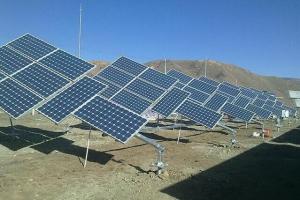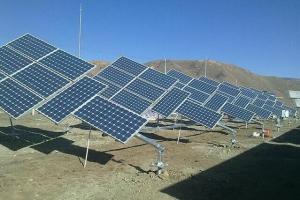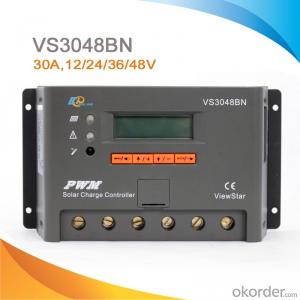MPPT Electronic Controller High Efficiency 45A Good Quality
- Loading Port:
- Shekou
- Payment Terms:
- TT or LC
- Min Order Qty:
- 100 pc
- Supply Capability:
- 100000 pc/month
OKorder Service Pledge
OKorder Financial Service
You Might Also Like
MPPT Electronic Controller High Efficiency 45A
1. MPPT Solar Charger Controller Characteristics:
1. MPPT Solar charge controller 20A,30A,40A
2. MPPT efficiency max 99%,Peak conversion efficiency >98%
3.PV input :100V or 145V max
4.12v/24v auto work
5.DSP processors architecture ensures high speed and performance
6.Four stages charging method
7.Protection :PV arry short circuit ,PV reverse polarity ,battery reverse polarity,over charging ,output short circuit.
2. MPPT Electronic Controller specifications:
| Model | PC16-4515A | PC16-6015A | |
| Default Battery System Voltage | 12V/24V/36V/48VDC (adjustable) | ||
| CONTROLLER INPUT | PV Open Circuit Voltage Range | 16V~100V for 12V battery system/32V~145V for 24V battery system/ 48V~145V for 36V battery system/64V~145V for 48V battery system | |
| Max PV Input Power(12V) | 600W | 800W | |
| Max PV Input Power(24V) | 1200W | 1600W | |
| Max PV Input Power(36V) | 1800W | 2400W | |
| Max PV Input Power(48V) | 2400W | 3200W | |
| BATTERY | Limited charge voltage | 15.5~16.0VDC/31.0~32.0VDC/46.5~48.0VDC/62.0~64.0VDC | |
| Equalizing charge voltage | 15.0~15.5VDC/30.0~31.0VDC/45.0~46.5VDC/60.0~62.0VDC | ||
| Boost charge voltage | 14.0~15.0VDC/28.0~30.0VDC/42.0~45.0VDC/56.0~60.0VDC | ||
| Float charge voltage | 13.2~14.0VDC/26.4~28.0VDC/39.6~42.0VDC/52.8~56.0VDC | ||
| Equalizing charge interval | 3~30day | ||
| Equalizing charge time | 1H~3H | ||
| Boost charge time | 1H~3H | ||
| DC OUTPUT | Output Voltage | 9.8~16.0VDC/19.6~32.0VDC/29.4~48.0VDC/ 39.2~64.0VDC | |
| Peak Conversion Efficiency | 98% (MPPT Efficiency 99%) | ||
| Max Charging Current | 45A | 60A | |
| Warning for low voltage | 11.8VDC/23.6VDC/35.4VDC/47.2VDC(Adjustable) | ||
| Cutoff for low voltage | 9.8VDC/19.6 VDC/29.4VDC/39.2VDC(Adjustable) | ||
| Low voltage recovery | 12.0~13.0VDC/24.0~26.0 VDC/36.0~39.0VDC/48.0~52.0VDC(Adjustable) | ||
| GENERAL SPECIFICATION | Charge mode | MPPT, PWM, constant current-constant voltage, function of automatic protection for storage battery | |
| Radiating mode | Air cooling | ||
| Working mode | Four stage: Absorption CC, Absorption CV, Float CC, Float CV | ||
| Light controlled open voltage | 5V | ||
| Light controlled delay time | 5min | ||
| DISPLAY & PROTECTION | LED indication | Systematic operation, LV indication, LV protection, over charge protection, loads protection, short circuit protection | |
| LCD display | Charge voltage, charge current, voltage of storage battery, capacity of storage battery, output current | ||
| Alarm Protections | PV array short circuit, PV reverser polarity | ||
| Battery reverse polarity, Over charging protection | |||
| Output short circuit protection | |||
| Low voltage protection for storage battery | |||
| MECHANICAL SPECIFICATIONS | Mounting | Wall mount | |
| W*H* D(mm)/G.W(kg) | 170*259*128mm/4.2kg | 170*289*128mm/4.8kg | |
| OTHER | Environmental Rating | Indoor | |
| Operation Temperature Range | -35~45°C | ||
| Ambient humidity | 0~90% relative humidity(non-condensing) | ||
| Altitude | ≤3000m | ||
3. MPPT Solar Charger Controller Production Line:
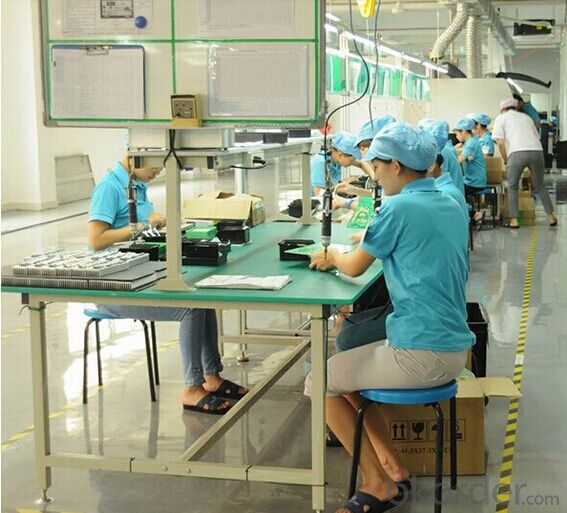
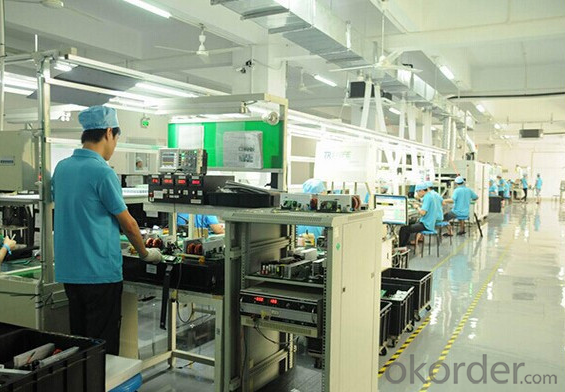
4. MPPT Solar Charger Controller FAQ:
We have organized several common questions for our clients, may help you sincerely:
1. How to choose a right solar controller?
Tell us your demand, then our sales will recommend a suitable one to you.
2. What is the solar inverter warranty?
Our product warranty is valid for 12 months after delivery. We undertake to repair any malfunctioned units due to defective components of inadequate workmanship ,but specially expecting any defects resulting from normal wear and tear of improper use of the products.
3. How long can we receive the product after purchase?
a.sample orders will be delivered from our factory within 7working days .
b.General orders(under 2000pcs) will be delivered from our factory within 25 working days.
c. Bulk orders (over 2000pcs )will be delivered from our factory within 35 working days at most
4. What is the payment term?
T/T (Telegraphic transfer) / Letter of credit
- Q:Can a solar controller be used with solar trackers?
- Yes, a solar controller can be used with solar trackers. A solar controller is typically used to regulate and optimize the charging of batteries in a solar power system. It monitors the voltage and current from the solar panels and ensures that the batteries are charged efficiently and safely. Solar trackers, on the other hand, are devices that follow the movement of the sun throughout the day, maximizing the solar energy output by keeping the solar panels aligned with the sun's position. They use motors or actuators to adjust the orientation of the solar panels. While solar controllers and solar trackers serve different functions, they can be used together in a solar power system. The solar controller will be connected to the solar panels and batteries to manage the charging process, while the solar tracker will adjust the position of the panels to capture the maximum amount of sunlight. By combining both technologies, the solar power system can benefit from increased energy generation and improved battery charging efficiency. This can lead to higher overall system performance and increased energy output.
- Q:What is the maximum discharge voltage for a solar controller?
- The maximum discharge voltage for a solar controller typically depends on its design and specifications. However, it is generally recommended to keep the discharge voltage between 11.5 and 12.5 volts to prevent over-discharge and potential damage to the battery.
- Q:Can I connect a solar controller directly to my battery bank?
- No, it is not recommended to connect a solar controller directly to your battery bank. A solar controller acts as a regulator to prevent overcharging and optimize the charging process for your batteries. By connecting a solar controller, you ensure the batteries are charged safely and efficiently, extending their lifespan.
- Q:How does a solar controller handle temperature compensation for battery charging?
- A solar controller handles temperature compensation for battery charging by monitoring the temperature of the battery and adjusting the charging voltage accordingly. As the temperature increases, the controller reduces the charging voltage to prevent overcharging and damage to the battery. Conversely, as the temperature decreases, the controller increases the charging voltage to compensate for the reduced battery capacity in colder conditions. This temperature compensation feature ensures optimal charging performance and extends the lifespan of the battery.
- Q:Can a solar controller be used with a solar-powered emergency backup system?
- Yes, a solar controller can be used with a solar-powered emergency backup system. A solar controller regulates the flow of energy from the solar panels to the backup system's battery, ensuring that it is charged efficiently and effectively. This helps to maintain the battery's health and prolong its lifespan. Additionally, a solar controller can provide important features such as overcharge protection and load control, which are crucial for the reliable operation of an emergency backup system.
- Q:Can a solar controller be used with solar panel tracking systems?
- Yes, a solar controller can be used with solar panel tracking systems. The solar controller helps regulate the charging and discharging of the batteries connected to the solar panel tracking system. It ensures that the batteries are charged efficiently and protects them from overcharging or discharging. Therefore, a solar controller plays a crucial role in optimizing the performance of solar panel tracking systems.
- Q:What is the role of a solar controller in preventing battery thermal runaway?
- The role of a solar controller in preventing battery thermal runaway is crucial. A solar controller, also known as a charge controller, is responsible for regulating the charging and discharging of batteries in a solar power system. It ensures that the batteries are charged at the optimal level and protects them from overcharging or discharging, which can lead to thermal runaway. Thermal runaway occurs when a battery becomes overheated, resulting in a rapid increase in temperature and potentially causing an explosion or fire. This can be caused by factors such as overcharging, excessive discharge rates, or high ambient temperatures. To prevent battery thermal runaway, a solar controller employs various mechanisms. One of the primary functions is to monitor the battery voltage and temperature. By continuously measuring these parameters, the controller can adjust the charging or discharging current to maintain the battery within safe limits. For example, if the temperature rises beyond a certain threshold, the controller can reduce the charging rate or turn off the charging altogether until the temperature returns to a safe range. Furthermore, a solar controller also incorporates safety features like temperature sensors and thermal shutdown mechanisms. These sensors detect abnormal temperature increases and trigger the shutdown of the charging process to prevent further heating. The controller may also have an alarm system or communication capabilities to alert the user or system operator about any potential issues. Additionally, some advanced solar controllers utilize advanced algorithms and intelligent charging profiles to optimize the charging process and minimize the risk of thermal runaway. These algorithms take into account factors such as the battery chemistry, capacity, and ambient conditions to deliver the most efficient and safe charging strategy. In summary, the role of a solar controller in preventing battery thermal runaway is to regulate the charging and discharging process, monitor battery voltage and temperature, implement safety features, and employ intelligent algorithms to maintain the battery within safe operating conditions. By doing so, it helps ensure the longevity and safety of the battery in a solar power system.
- Q:How do I connect a solar controller to a solar-powered water heater?
- To connect a solar controller to a solar-powered water heater, start by identifying the appropriate terminals on both the controller and the water heater. Typically, the controller will have labeled terminals for connecting the solar panel, battery, and load. The solar-powered water heater should have terminals for connecting the solar collector and the storage tank. Once you have identified the terminals, connect the solar panel's positive wire to the controller's solar panel terminal, and the negative wire to the controller's negative/ground terminal. Next, connect the solar collector's positive wire to the water heater's solar collector terminal, and the negative wire to the water heater's negative/ground terminal. Ensure all connections are secure and tight, and then power on the solar controller. The controller will regulate the energy flow from the solar panel to the water heater, maximizing efficiency and temperature control. Make sure to consult the user manuals for both the solar controller and water heater for any specific instructions or nuances related to your particular setup.
- Q:How does a solar controller handle short-circuit conditions?
- A solar controller typically handles short-circuit conditions by detecting the excessive flow of current and immediately shutting off the circuit to prevent damage to the system.
- Q:Can a solar controller be used in a solar-powered cruise ship?
- Yes, a solar controller can be used in a solar-powered cruise ship. A solar controller regulates the voltage and current from the solar panels to charge the batteries efficiently, which is essential for any solar-powered system, including a cruise ship. It helps to optimize the energy generation and storage process, ensuring a reliable and stable power supply for the ship's operations.
1. Manufacturer Overview |
|
|---|---|
| Location | |
| Year Established | |
| Annual Output Value | |
| Main Markets | |
| Company Certifications | |
2. Manufacturer Certificates |
|
|---|---|
| a) Certification Name | |
| Range | |
| Reference | |
| Validity Period | |
3. Manufacturer Capability |
|
|---|---|
| a)Trade Capacity | |
| Nearest Port | |
| Export Percentage | |
| No.of Employees in Trade Department | |
| Language Spoken: | |
| b)Factory Information | |
| Factory Size: | |
| No. of Production Lines | |
| Contract Manufacturing | |
| Product Price Range | |
Send your message to us
MPPT Electronic Controller High Efficiency 45A Good Quality
- Loading Port:
- Shekou
- Payment Terms:
- TT or LC
- Min Order Qty:
- 100 pc
- Supply Capability:
- 100000 pc/month
OKorder Service Pledge
OKorder Financial Service
Similar products
New products
Hot products
Hot Searches
Related keywords
